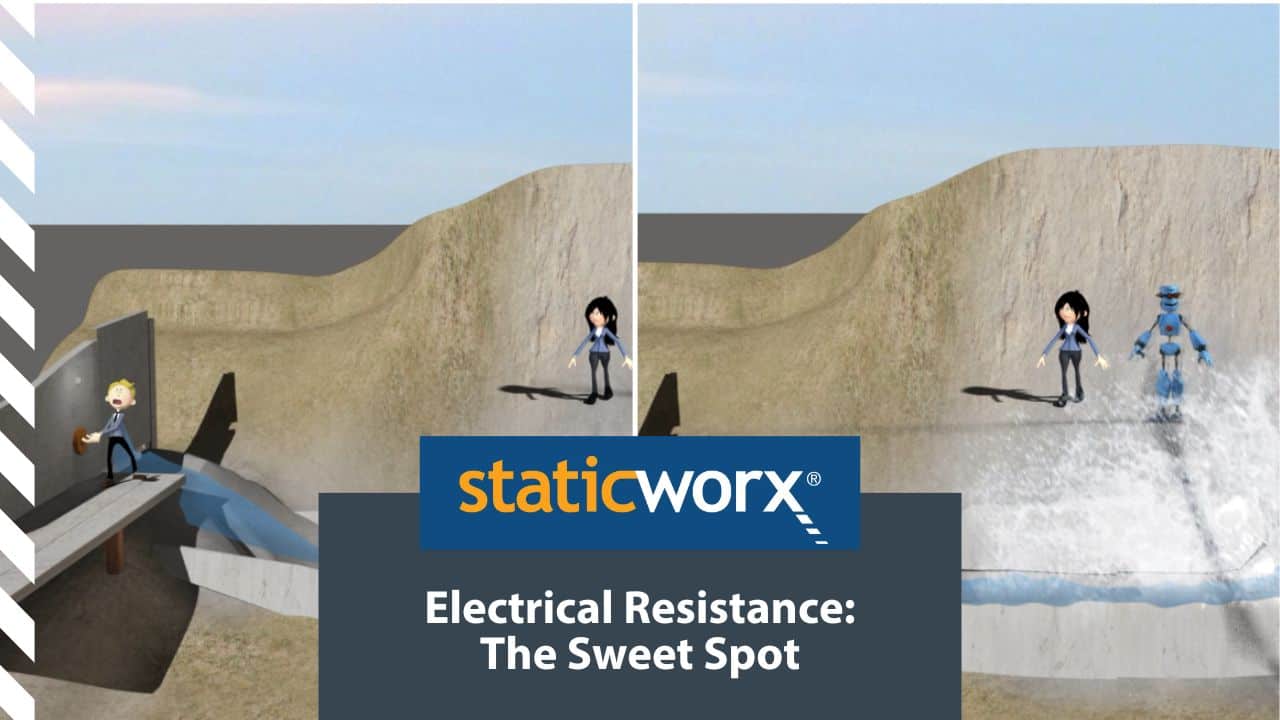
Video: Testing Your ESD Floor
February 3, 2011
Short video about how to test the resistance of ESD flooring.
Click here for our most up to date video on measuring electrical resistance.
Visit our Learning Center for more information on electrical resistance.
For help or advice about choosing an ESD floor, call us on 617-923-2000, email [email protected], or visit our Guide to ESD Flooring Selection.
Hi, I’m Dave Long, the President of StaticWorx and in this video we’re going to talk about how to test ESD flooring.
The first thing we’re going to talk about is how not to test ESD flooring. Typically, if we get a phone call from one of our clients and they tell us that they’ve tested the floor and they can’t get a reading, the first thing we ask them is are you using a standard volt ohmmeter and the answer is always yes. I have one in my hand and you’ll notice that there’s a red lead and a black lead and each of these leads has a little pin on the end of it and unfortunately these little pins do not make enough contact area with the conductive floor to get a reading.
The probes we use are three inches in diameter and the reason we do that is because we’re contacting a surface that has a bunch of veins in it and those veins are conductive and in order to make good contact with them you need a large surface. So when you test an ESD floor you have to use what’s called an NFPA probe. I’ve got two of them here. What I’m going to do is quickly show you how I’m going to test this tile and find out if in fact it’s conductive.
So what we’re going to do is take the tile, we’re going to place it on this copper strip which is right here, which is what we use to ground ESD flooring. I’m going to put one of the probes on the tile, I’m going to set the other probe on the piece of copper. They’re both connected to this ohmmeter.
Hit our test button, we get a reading. If the reading is between 25,000 ohms and a million ohms and the spec sheet says the floor is supposed to be conductive, that’s acceptable. If the reading is between a million and a billion ohms and the spec sheet says it’s a static-dissipative floor, that’s an acceptable reading and so we’re right in the middle of what we would call a safe specification.
The second test we perform is what we call a point-to-point resistance test. In that test we take the two probes, we set them on the surface of the floor. We don’t attach them to ground. We actually just test from one point on the surface to a second point on the surface. One of the reasons we do that, is we want to find out if the floor is more conductive point-to-point than it is point-to-ground. If it is more conductive, that can possibly lead to a safety hazard. Sometimes in our testing we’ve discovered the carpet tile might read a million ohms to ground but when we test the top surface we find out that it’s eight or ten thousand ohms to ground. That would actually present a potential shock hazard if somebody touched 120 volt line voltage.
So a lot of what we’re doing here isn’t just to find out if the floor is adequately eliminating static, we’re also trying to find out, is it a safe condition to turn over to the owner when people occupy the space.
For a little more information on testing I’d suggest you go to our website www.staticworx.com and look for an article called “Potential Conflicts with ESD Flooring.” You’ll find out a lot more about testing than we’ve talked about here today. In roughly two minutes, I’ve covered a topic that we could really spend all day discussing.
If you want to reach me directly to talk about it, you can reach me at [617-923-2000].
Learning Center Articles
- ESD Basics
- Installation & Maintenance
- Selecting & Specifying an ESD Floor
- Technical Information
- 7 Common Mistakes Selecting an ESD floor
- A Guide to ESD Flooring Selection
- Avoid Costly Failures: What You Need to Know When Specifying ESD Flooring
- Choosing ESD Flooring for:
- ESD Footwear: What Is It and When Is It Necessary?
- ESD Footwear for Electronics Manufacturing and Handling Applications
- Facility Managers’ Guide to Selecting ESD Flooring
- The Need for Due Diligence in Specifying Static-Free Flooring
- Standard of Care for Specifying Floors in Mission-Critical Spaces
- Understanding the Hidden Costs of ESD Flooring

StaticWorx high-performance static-control floors protect electronic components, explosives, and high-speed computers from damage caused by static electricity. ESD flooring is part of a system. Choices should always be based on objective, researched evidence. When you partner with us, we look at all possible items that may need to integrate with the floor, and, focusing on your goals and objectives, help you find the right floor for your application.










